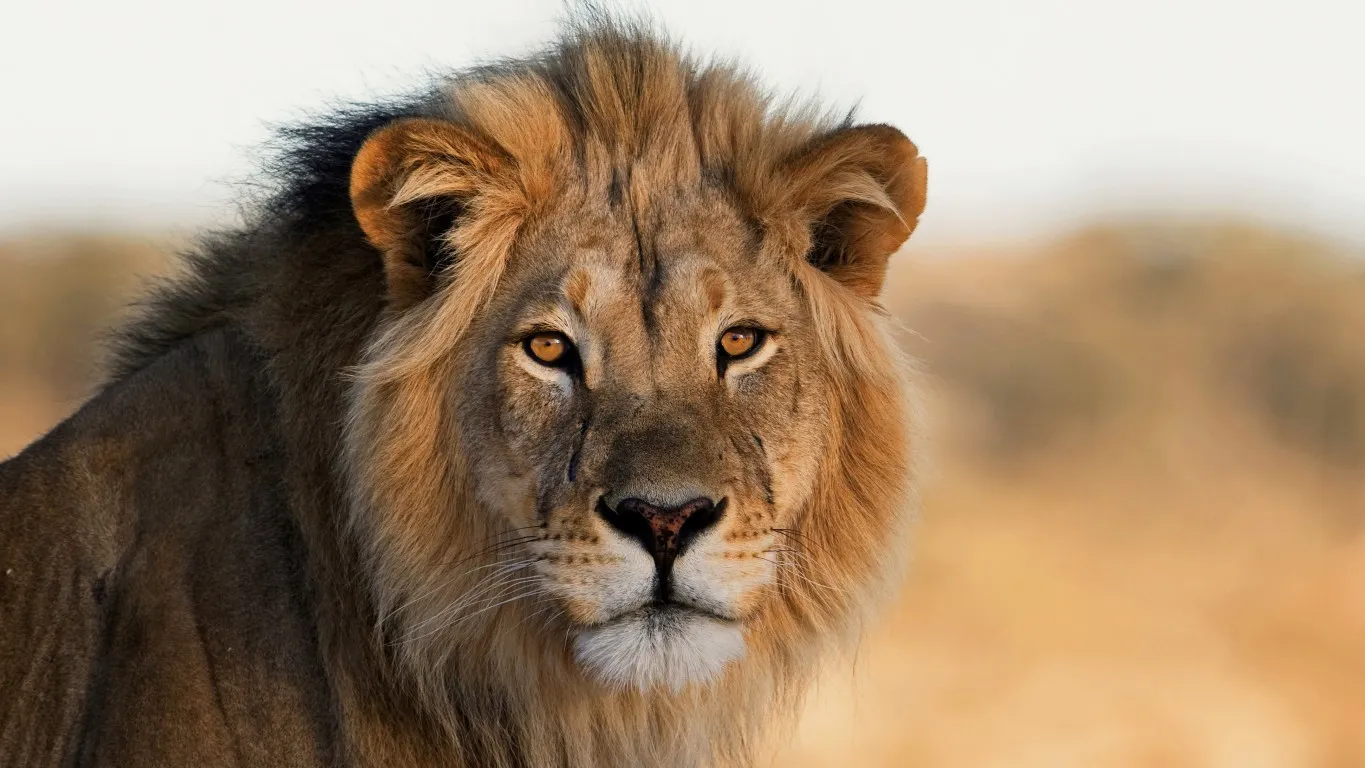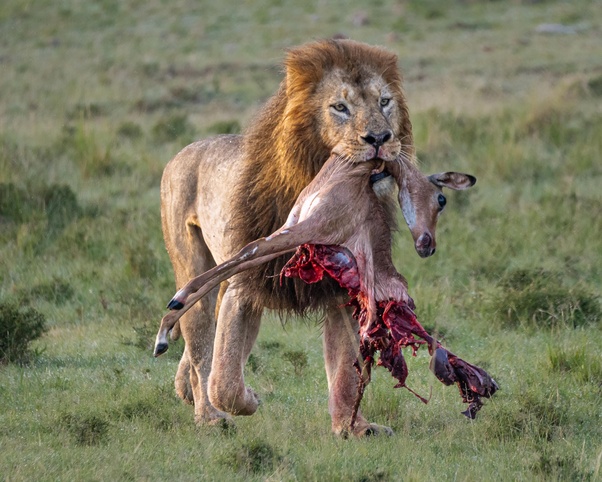Lions and tigers are two of the most majestic and powerful members of the cat family. Lions, known for their impressive manes, are social animals that live in groups called pride, predominantly found in Africa.
They are symbolized as kings of the jungle, known for their strength and nobility. Tigers, on the other hand, are solitary creatures native to Asia, recognized for their striking striped coats.
They are the largest of all wild cats and are revered for their power and grace. Both species are apex predators, playing crucial roles in their respective ecosystems.
What is a Lion?
The lion, scientifically known as Panthera Leo, is one of the most recognizable and revered animals in the world. As a symbol of strength and courage, lions have been celebrated throughout history in various cultures.

Adult male lions are particularly noted for their majestic manes, which signify maturity and rank. Females, or lionesses, are the primary hunters of their pride and work cooperatively to catch prey, mostly large ungulates like wildebeest, zebra, and buffalo.
They are also the sole felines who live in groups, also known as prides. A pride typically consists of several related females, their cubs, and a small group of males.
This social structure is unique among big cats and is a crucial aspect of lion life, contributing to their hunting strategy and raising of cubs.
Once widespread across Africa, Asia, and Europe, lions are now found predominantly in sub-Saharan Africa, with a critically endangered population in the Gir Forest of India.
They inhabit a variety of habitats, from open plains to scrublands and savannas, but they avoid dense forests. Unfortunately, lion populations have been declining due to habitat loss, conflict with humans, and other factors, leading to their classification as vulnerable by the International Union for Conservation of Nature (IUCN).
Conservation efforts are ongoing to protect and increase the remaining lion populations, ensuring the survival of this magnificent animal for future generations.
What is a Tiger?
The tiger, with its scientific name Panthera tigris, is one of the most awe-inspiring and charismatic animals on our planet. Known for its striking coat of reddish-orange with dark stripes, each tiger’s pattern is unique, much like a human fingerprint. As the largest of all wild cats, tigers can weigh up to 660 pounds (300 kilograms) and measure up to 11 feet (3.3 meters) in length, including their tail.

Tigers are predators of the highest order, mostly preying on ungulates, like wild boar and deer. They are solitary creatures, territorial, and generally avoid each other except during mating season or when a mother is raising her cubs. Unlike many other cats, tigers are comfortable in the water and are known to be good swimmers.
These majestic animals once roamed widely across Asia, from the Russian Far East through parts of North Korea, China, India, and Southeast Asia to the Indonesian island of Sumatra.
Their range has significantly shrunk due to habitat loss and poaching. As a result, tigers are listed as endangered by the International Union for Conservation of Nature (IUCN). Various subspecies, like the Siberian, Bengal, and Sumatran tigers, are under severe threat, with some, like the Javan and Bali tigers, already extinct.
Conservation efforts for tigers involve habitat protection, anti-poaching measures, and initiatives to reduce human-tiger conflicts. These efforts are crucial in ensuring the survival of tigers in the wild, preserving not only an iconic species but also the biodiversity of the ecosystems in which they live.
Importance of understanding their differences
Understanding the differences between lions and tigers is important for several reasons:
- Conservation Efforts: Each species faces unique challenges in its natural habitats. For example, lions are struggling with habitat loss and human-wildlife conflict in Africa, while tigers face severe threats from habitat fragmentation and poaching in Asia. Recognizing these distinct challenges is crucial for developing targeted conservation strategies.
- Educational Value: Learning about these differences enhances our knowledge and appreciation of biodiversity. It helps in educating the public about the importance of wildlife conservation and the specific needs of different species.
- Scientific Understanding: Studying the variations in behavior, habitat, and physiology between lions and tigers contributes to a broader understanding of felid biology and ecology. This knowledge can be critical in fields like genetics, conservation biology, and animal behavior.
- Zoo Management and Animal Care: In zoos and wildlife sanctuaries, understanding the specific needs of each species—ranging from diet to social structure—is essential for their proper care and welfare.
- Cultural Significance: Both animals have significant roles in the culture and folklore of various societies. Understanding their differences allows for a deeper appreciation of their symbolic meanings across different cultures.
- Preventing Misinformation: Misconceptions about wildlife can lead to inappropriate attitudes and actions towards these animals. Accurate knowledge helps in dispelling myths and fosters a more informed public discourse about wildlife.
Understanding the differences between lions and tigers is vital for effective conservation, educational outreach, scientific research, and fostering a deeper appreciation of these magnificent creatures in the context of their ecological and cultural significance.
Comparison table of Lion and Tiger
Here’s a comparison table highlighting the key differences between lions and tigers:
| Feature | Lion (Panthera leo) | Tiger (Panthera tigris) |
|---|---|---|
| Size and Weight | Males: Up to 420 lbs (190 kg), 6-8 ft (1.8-2.4 m) Females: Smaller than males | Up to 660 lbs (300 kg), 8-11 ft (2.4-3.3 m) Similar sizes in both genders |
| Habitat | Primarily in Sub-Saharan Africa, a small population in Gir Forest, India | Native to Asia, including Russia, India, China, and Southeast Asia |
| Coat and Appearance | Tan or golden coat, males with a distinctive mane | Reddish-orange coat with black stripes |
| Social Structure | Live in groups called pride | Solitary, except during mating season or when a mother is with cubs |
| Diet | Carnivorous, primarily hunt large ungulates | Carnivorous, mainly deer and wild boar |
| Hunting Style | Females hunt in groups | Solitary hunters |
| Vocalization | Known for roars | Less vocal, but can roar |
| Conservation Status | Listed as Vulnerable | Listed as Endangered |
| Unique Features | Only cat species that live in social groups | Largest of all wild cats, excellent swimmer |
Physical Characteristics
Lions and tigers, as top predators, possess a range of physical characteristics that are both unique to each species and shared between them. Here’s a detailed look at these characteristics:
Lions (Panthera leo)
- Size and Build: Adult male lions are generally larger and heavier than females. Males weigh between 330 and 570 pounds (150 and 260 kg), while females weigh 265 to 400 pounds (120 to 180 kg). They are muscular with a robust build.
- Mane: The most distinctive feature of male lions is their mane, which varies in color from light to dark brown. The mane can also indicate the lion’s health and vigor.
- Coloration: Lions have a uniform coloration of sandy or tawny, which helps them blend into their savanna habitat.
- Tail: Lions have a unique tuft of hair at the end of their tails.
- Social Behavior: Lions are social cats and the only ones that live in groups (pride).
Tigers (Panthera tigris)
- Size and Build: Tigers are the largest of all wild cats. An adult male can weigh between 400 and 660 pounds (180 and 300 kg). They have a stocky and muscular build.
- Coat: Tigers have a distinctive coat color of reddish-orange with black stripes. The pattern of stripes is unique to each tiger, similar to human fingerprints.
- Physical Variations: There are several subspecies of tigers, such as the Siberian tiger, which is the largest, and the Sumatran tiger, which is smaller and has a darker coat.
- Tail: Tigers have long tails, which help them balance when making sharp turns during a chase.
- Solitary Nature: Tigers are solitary animals and mark large territories.
Shared Characteristics
- Eyesight: Both have excellent night vision, which is crucial for hunting in low-light conditions.
- Teeth and Claws: Sharp retractable claws and strong jaws with sharp teeth are characteristic of both, enabling them to grab and hold onto their prey.
- Carnivorous Diet: Both are apex predators, primarily feeding on large mammals.
- Roaring Ability: Lions and tigers can roar, a feature unique to the ‘big cats’ of the Panthera genus.
- Sensory Abilities: Both species have acute senses of hearing and smell, which are essential for hunting and communication.
These physical characteristics are adaptations that have evolved to suit their roles as top predators in their respective ecosystems.
Behavior and Social Structure
Lions and tigers exhibit distinct behaviors and social structures, shaped by their evolutionary adaptations and ecological niches.
Lion Behavior and Social Structure:
- Social Structure: Lions are atypical among large cats because of their social nature and structure. They live in groups known as prides, which typically consist of several adult females, their cubs, and a few adult males.
- Pride Dynamics: Within the pride, there is a hierarchy, with dominant males and females. The females in a pride are usually related and stay with the group for life.
- Males: Male lions are responsible for defending the pride’s territory and can often be found marking the area with their scent or roaring to ward off intruders.
- Cub Rearing: Lionesses in pride often synchronize their breeding, leading to communal rearing and protection of cubs.
- Social Interactions: Lions are known for their social behavior, including grooming and playing, which strengthens bonds within the pride.
Tiger Behavior and Social Structure:
- Solitary Nature: Tigers are solitary animals. They come together only for mating purposes or when a mother is raising her cubs.
- Territorial: Both male and female tigers are highly territorial. They mark their territories with urine, feces, and scratch marks to warn other tigers away.
- Mother and Cubs: Tiger cubs stay with their mother for about two years, learning how to hunt and survive. Once they are old enough, they leave to establish their territories.
- Communication: Tigers communicate through vocalizations, scent markings, and visual signals. They are less vocal compared to lions and rely more on scent and visual markers for communication.
Lions exhibit a unique social structure among big cats, living and working in groups, whereas tigers are more solitary, only interacting significantly during mating seasons and in the mother-cub relationship.
These differences in behavior and social structure are key to understanding the ecological roles and adaptations of these magnificent animals.
Hunting Techniques and Diet
Lions and tigers, as apex predators, have developed specific hunting techniques and diets that are adapted to their environments and physical capabilities.
Lion Hunting Techniques and Diet:

- Hunting in Groups: Lions often hunt in coordinated groups called prides. This social structure is unique among big cats.
- Ambush and Stalk: They typically use a combination of stalking and ambush tactics, utilizing the strength of the group to take down large prey.
- Prey: Their diet primarily consists of large ungulates such as zebras, wildebeests, and antelopes. They are also known to hunt smaller animals when larger prey is scarce.
- Opportunistic Feeders: Lions can scavenge and will take over kills made by other animals if the opportunity arises.
Tiger Hunting Techniques and Diet:

- Solitary Hunting: Tigers are solitary hunters. They rely on stealth and strength, hunting alone.
- Ambush Predators: They typically use ambush tactics, utilizing their striped fur as camouflage in tall grass or dense vegetation.
- Prey Selection: Tigers prefer to hunt medium to large-sized ungulates like deer, wild boar, and sometimes larger animals such as gaur (Indian bison) and water buffalo.
- Swimming Skills: Unlike lions, tigers are strong swimmers and can hunt in water, expanding their prey range to include aquatic animals in some regions.
Both lions and tigers are skilled hunters, but their methods reflect their distinct lifestyles. Lions, as social animals, hunt in groups and share their kills, while tigers, as solitary creatures, rely on individual prowess and typically hunt and eat alone.
Similarities between Lion and Tiger
Lions and tigers, despite their differences, also share several similarities:
- Classification: Both lions and tigers belong to the Felidae family and the Panthera genus, classifying them as big cats.
- Apex Predators: They are apex predators in their respective ecosystems, playing a crucial role in controlling the population of other animals and maintaining ecological balance.
- Carnivorous Diet: Both species are strictly carnivorous, relying heavily on hunting and consuming other animals for survival. Their diets typically consist of large mammals.
- Physical Adaptations: Lions and tigers have evolved several similar physical features ideal for hunting, such as strong muscular bodies, sharp claws, and keen senses.
- Territorial Behavior: Both animals are territorial and mark their territories to ward off competitors, although tigers tend to have larger territories than lions.
- Vocalizations: Both species can roar, a trait that is unique to the genus Panthera. Their roars serve as communication tools, for instance, to establish territory or call members of their group.
- Endangered Status: Both lions and tigers face threats from human activities. Habitat loss, poaching, and human-wildlife conflict have led to their declining populations, making conservation efforts critical for their survival.
- Cultural Significance: Lions and tigers hold significant places in various cultures and mythologies around the world, symbolizing strength, royalty, and bravery.
- Solitary vs. Social Behaviors: While lions are more social, tigers are predominantly solitary; however, both species show some level of social behavior, such as a mother’s care for her cubs and, in the case of lions, cooperative hunting and pride dynamics.
Understanding these similarities is important in appreciating the common challenges they face and the shared characteristics that define them as top predators in their respective habitats.
Summary
Lions and tigers, each iconic in their own right, are apex predators vital to their ecosystems. Lions, social and cooperative, dominate the African savannas, while solitary tigers stealthily navigate the forests of Asia.
Despite their prowess, both face threats from human activities, underscoring the need for conservation efforts to ensure these magnificent creatures continue to thrive in their natural habitats.

